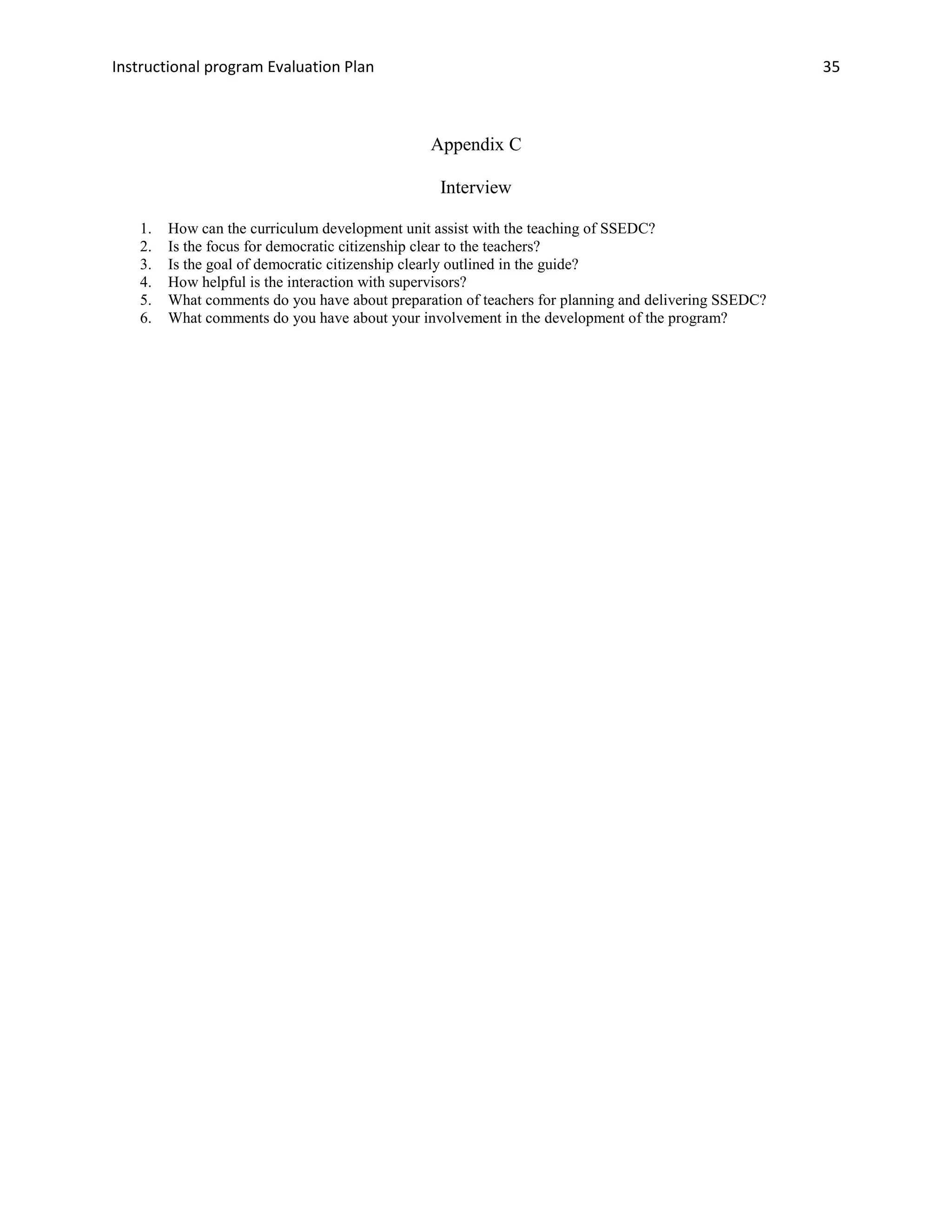The document outlines a systematic formative evaluation plan for the implementation of social studies education for democratic citizenship (ssedc) in grades K-6. It details the evaluation committee structure, methodology, and goals, emphasizing mixed methods to collect both quantitative and qualitative data from various school community stakeholders. The aim is to identify strengths and weaknesses in the program's implementation to recommend improvements and foster accountable citizenship education in schools.
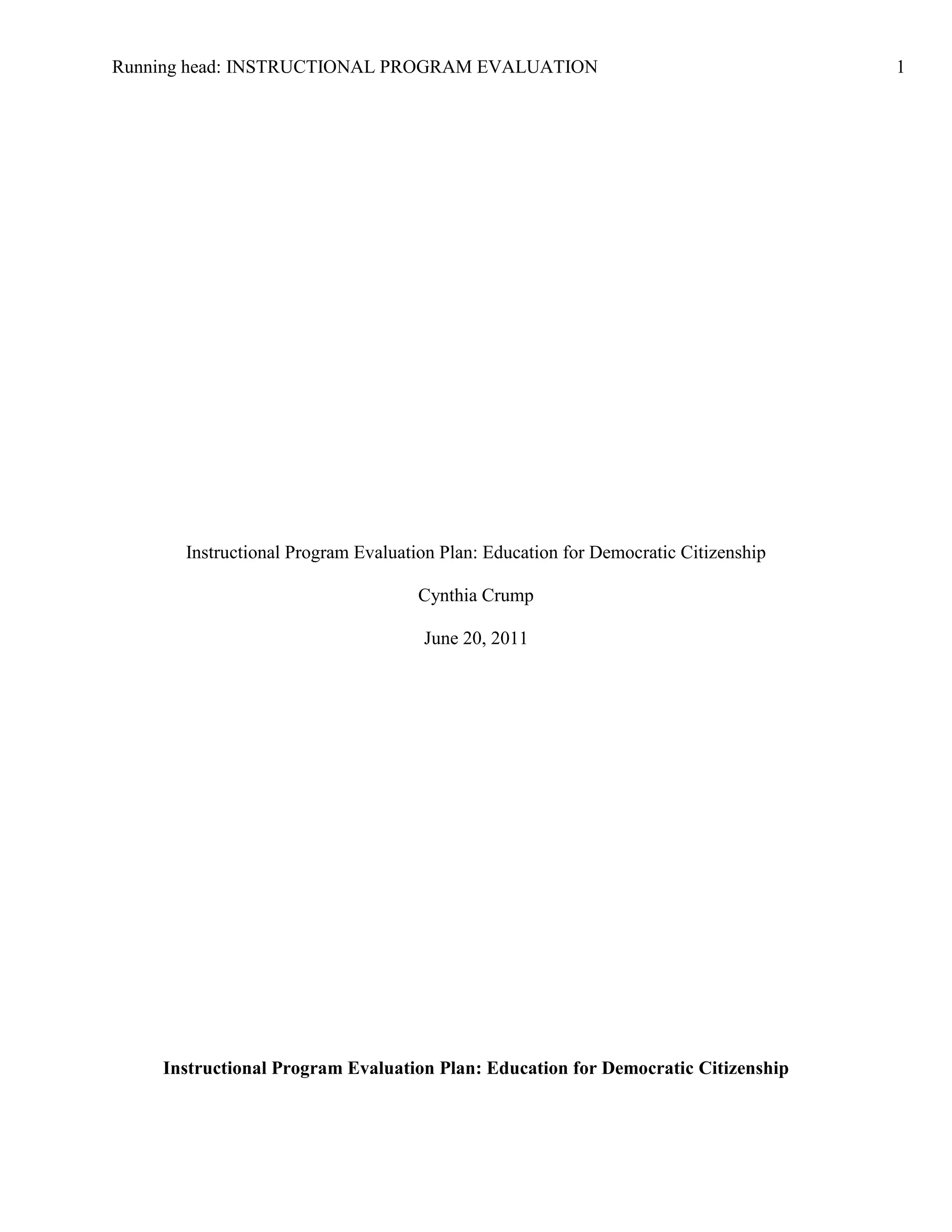
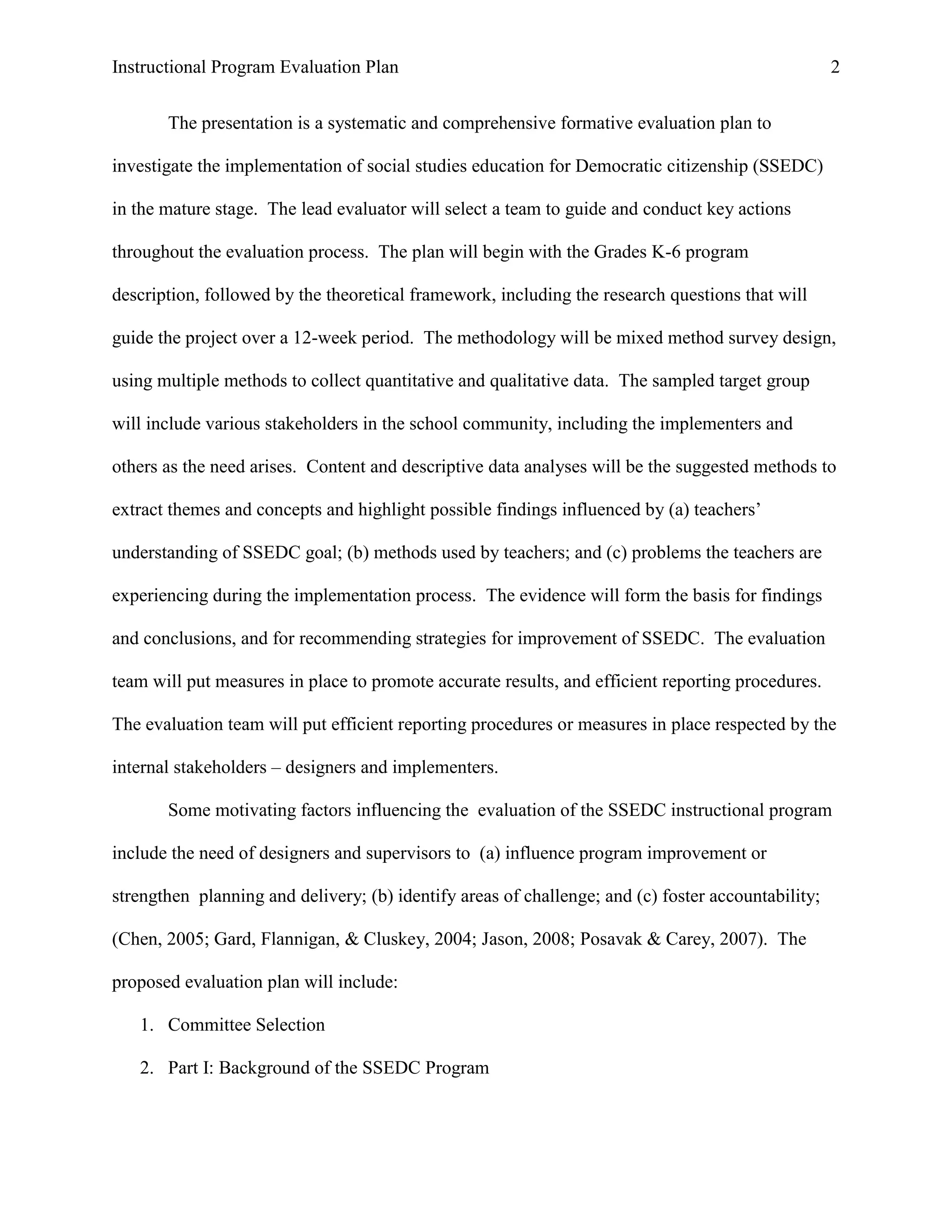
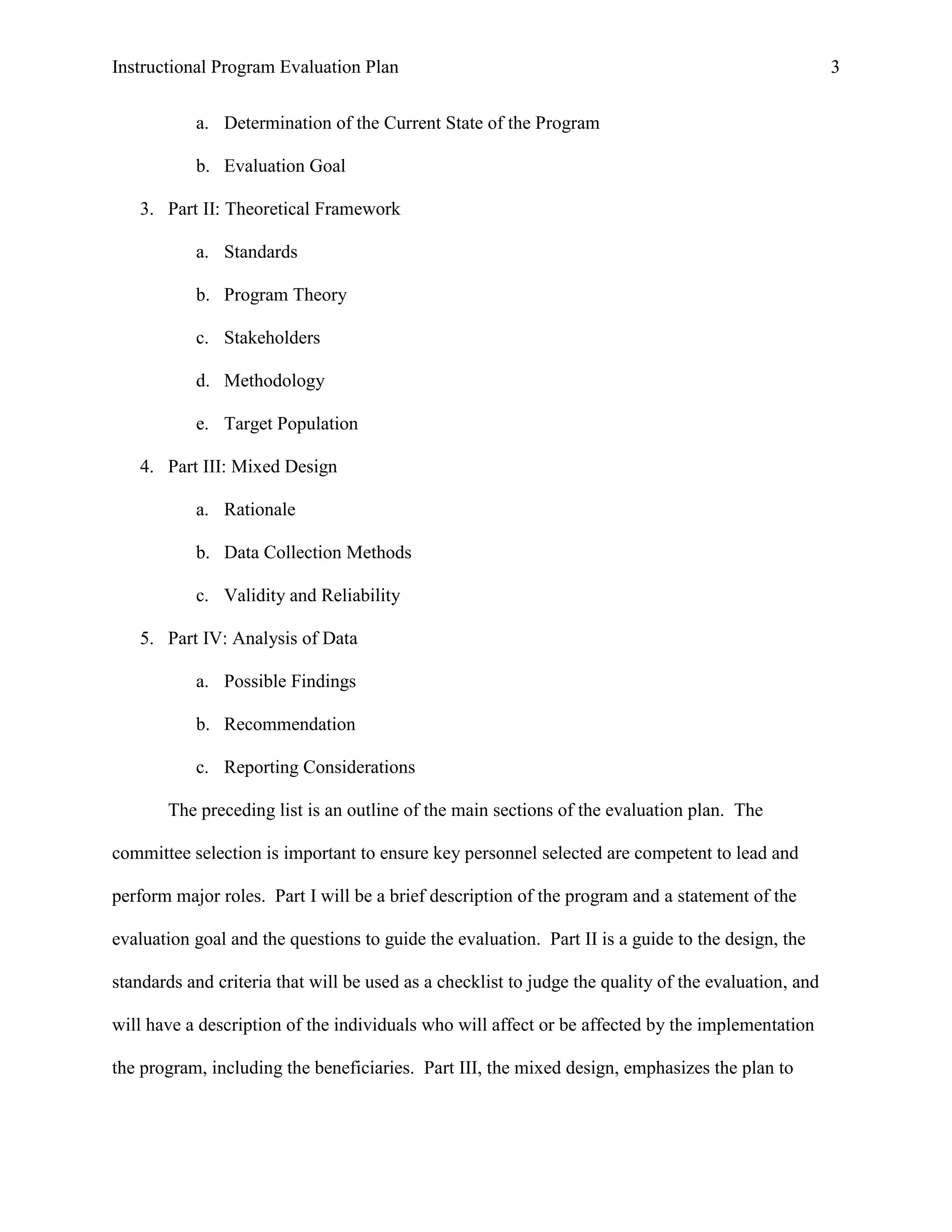
![Instructional Program Evaluation Plan 4
conduct a detailed evaluation by means of multiple data collection tools, from multiple sources.
In Part IV, possible findings from the data analysis will provide the basis for suggestions to
improve the program. The presentation will form the basis to conduct a formative process
evaluation and provide recommendations for improvement of teachers‟ implementation of
SSEDC.
Committee Selection
The director, supervisor, one other education officer, teachers, principals, a community
member, a parent, and a private school principal, a school mentor, will comprise the evaluation
committee. The responsibility of the committee members is to respond to the strengths and
challenges of the program to refine the program. Gard, Flannigan, and Cluskey (2004) cited the
evaluation committee has the responsibility “to use data to identify strengths and weaknesses of
the program” (p. 176).
The coordinator of the development and revision processes and the supervisor coupled
with the stakeholders in the school community “…. are vital to the survival and success of the
[program]” (Gard et al., 2004, p. 4). Collaboration with external evaluators will ensure a
supportive environment (Chen, 2005). The director must guard against bias and conflict of
interests (Posavac & Carey, 2007) because of involvement in all stages of the program. Ethics
and values are two elements necessary to plan, conduct, and evaluate a program to ensure
accuracy of results. Using external and internal evaluators would help to lessen or eliminate
perceived internal bias while empowering internal and external stakeholders (Chen).
Part I: Background of the SSEDC Program
Before 2006, the last attempt at social studies curriculum review and renewal was in the
late 1980s, supported by USAID curriculum specialists. After a quarter of a century, rebranding](https://image.slidesharecdn.com/programevaluationplan-130809205232-phpapp02/75/Program-evaluation-plan-4-2048.jpg)
![Instructional Program Evaluation Plan 5
of the social studies curriculum was necessary including renaming the program to social studies
education for Democratic citizenship (SSEDC). Besides datedness, factors, affecting the social
behaviors of citizens, especially among the youth, influenced the development of SSEDC.
In 2007, a team, including the Director of Curriculum as expert, a core of teachers, and
representatives from the environment ministry, completed a first draft of SSEDC. After several
reviews, SSEDC was piloted among a sample of schools and classes (K –9), over a period of 12
weeks in 2008. At various review sessions, all grade teachers had the opportunity to input
changes, based on the results and recommendations of the pilot implementation data.
Implementation of the revised instructional program took place in September 2009, Familiarity
seminars and training workshops were actions to develop teacher competence and support the
implementation. Between 2009 and present, the director, the supervisor, education officers,
principals, and senior teachers continue to conduct monitoring of the SSEDC.
Goals of SSEDC
The following is a section of the rationale of SSEDC (Ministry of Education, 2009)
outlining several reasons that influenced program development.
First, in Antigua and Barbuda [is] a Democratic state; independent from Britain
since 1981; Education for Democratic Citizenship (EDC) would mean that the
main outcome of schooling should be citizens with civic consciousness; not only
equipped with knowledge but[also have] the ability to demonstrate skills
appropriate to such a citizen, who also exhibit democratic values. Second, there
appears to be a democratic deficit. A high percentage of individuals (youth) do
not vote or even show much interest in politics. SSEDC should help to improve
individuals‟ levels of understanding of their lives and how they interact within](https://image.slidesharecdn.com/programevaluationplan-130809205232-phpapp02/75/Program-evaluation-plan-5-2048.jpg)
![Instructional Program Evaluation Plan 6
society. Third, [because the mid-2000s] there has been an upsurge of crime and
violence. Of particular interest are the negative activities among the youth. These
include school violence, drug-related violence, increases in cases of HIV/AIDS,
home invasions coupled with robbery and rape, murders, and other gun-related
crimes. Fourth, surge in migration of Caribbean neighbors and an influx of other
migrants from China has opened up the avenue for the focus on themes, such as
civic ideals and practices, identity, traditions, multiculturalism, cultural diversity
and tolerance. All citizens need to tolerate peoples from other places, and also to
tolerate their differences (p. 1)
The focus of SSEDC is on relationships to promote (i) understanding the role and
responsibility of citizens in a democratic society and (ii) awareness of the link and
interdependence locally, regionally, globally. The overarching goal of SSEDC is citizenship;
achievable through:
1. Knowledge of social issues and concerns;
2. Skill development;
3. Development of values and attitudes; and
4. Social participation (p. 3)
Teachers should provide the preceding experiences. The program„s rationale and goal
emphasize the outcome capabilities including knowledge, skills, values, and dispositions the
students should achieve. Students should also receive opportunities to participate in the society
by transferring classroom learning to perform the role of productive citizens. These long-term
outcomes should drive lesson objectives as well as the teaching learning experiences.](https://image.slidesharecdn.com/programevaluationplan-130809205232-phpapp02/75/Program-evaluation-plan-6-2048.jpg)
![Instructional Program Evaluation Plan 7
The director introduced the instructional guide with the following statement adapted from
the Organization of Eastern Caribbean States Educational and Research Unit (OERU):
The [program] offers a range of ideas and suggestions to help teachers
organize participatory learning experiences designed to prepare students
for lifelong learning”…. Social studies classrooms place major emphasis
on student-centered learning through the acquisition and development of
specific cognitive skills and competencies. The focus is on learning
through activities, practice, and participation…. These skills are expected
to produce the ultimate outcomes of SSEDC: students as citizens,
acquiring and demonstrating social understanding and civic efficacy”
(Ministry of Education, 2009, p. 2)
Social and Contextual Factors
The SSEDC Instructional program is a part of private and public schools curriculum.
The pilot implementation findings highlighted some gaps and the intent of the review was to
improve on the program. Currently, the curriculum unit personnel conduct support and
monitoring evaluation to provide feedback information on a regular basis to facilitate supervision
of the program. The qualitative and quantitative reports obtained from observation of teaching
using a rating scale, reflections, the classroom environment, students‟ work, and the interactions
reveal areas that mentors could assist with on a continuous basis.
Determination of the Status of the Program
The monitoring in public schools revealed variations exist in the teaching-learning
contexts within and across schools and classes that result in differentiated delivery and students‟
learning experiences. The nature of school leadership and support, supporting materials, and out](https://image.slidesharecdn.com/programevaluationplan-130809205232-phpapp02/75/Program-evaluation-plan-7-2048.jpg)


![Instructional Program Evaluation Plan 10
ii. Provide assurance that each has the expertise or support required to
complete the work.
2. Feasibility
a. Practical procedures
i. Implement practical and responsive procedures aligned with the
operation of the program.
3. Propriety
a. Human rights and respect
i. Design and conduct evaluation to protect human and legal rights and
maintain the dignity of participants and stakeholders.
4. Accuracy
a. Sound designs and analyses
i. Employ technically adequate designs and analyses appropriate for the
purpose of the evaluation
The description of the standards supports the importance of the stakeholders developing trust in
the expertise of the evaluator to plan and implement appropriate procedures and designs to
promote successful and valid evaluation. Stakeholders must also feel protected and respected.
The following discussion will support how the standards will influence the plan in the choice of
theory, stakeholders, model, design, and human rights and respect.
Program Theory
Chen (2005) supported the view program theory is useful in “improving the
generalizability of evaluation results, contributing to social science theory, uncovering
unintended effects,… achieving consensus in evaluation planning…[and providing] …early](https://image.slidesharecdn.com/programevaluationplan-130809205232-phpapp02/75/Program-evaluation-plan-10-2048.jpg)
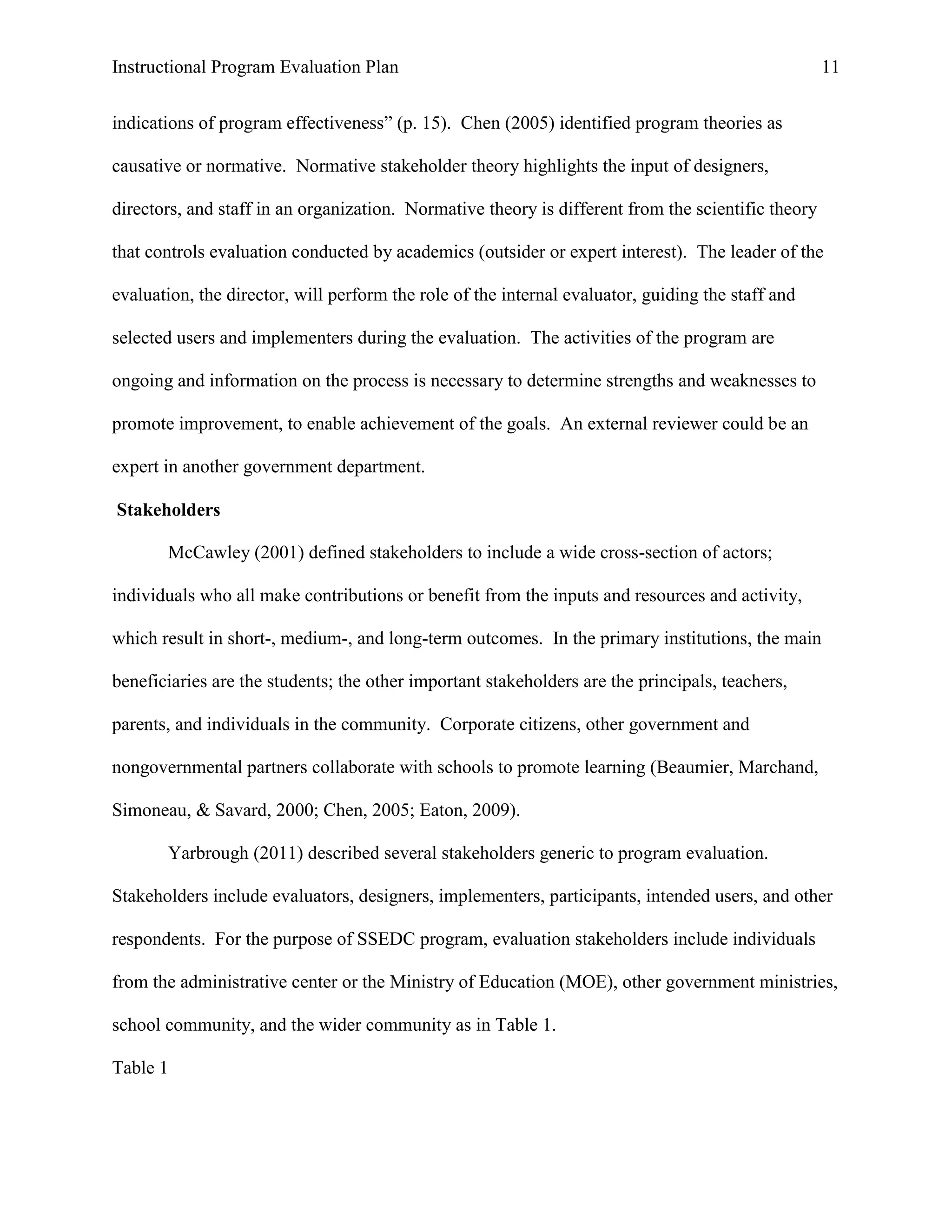
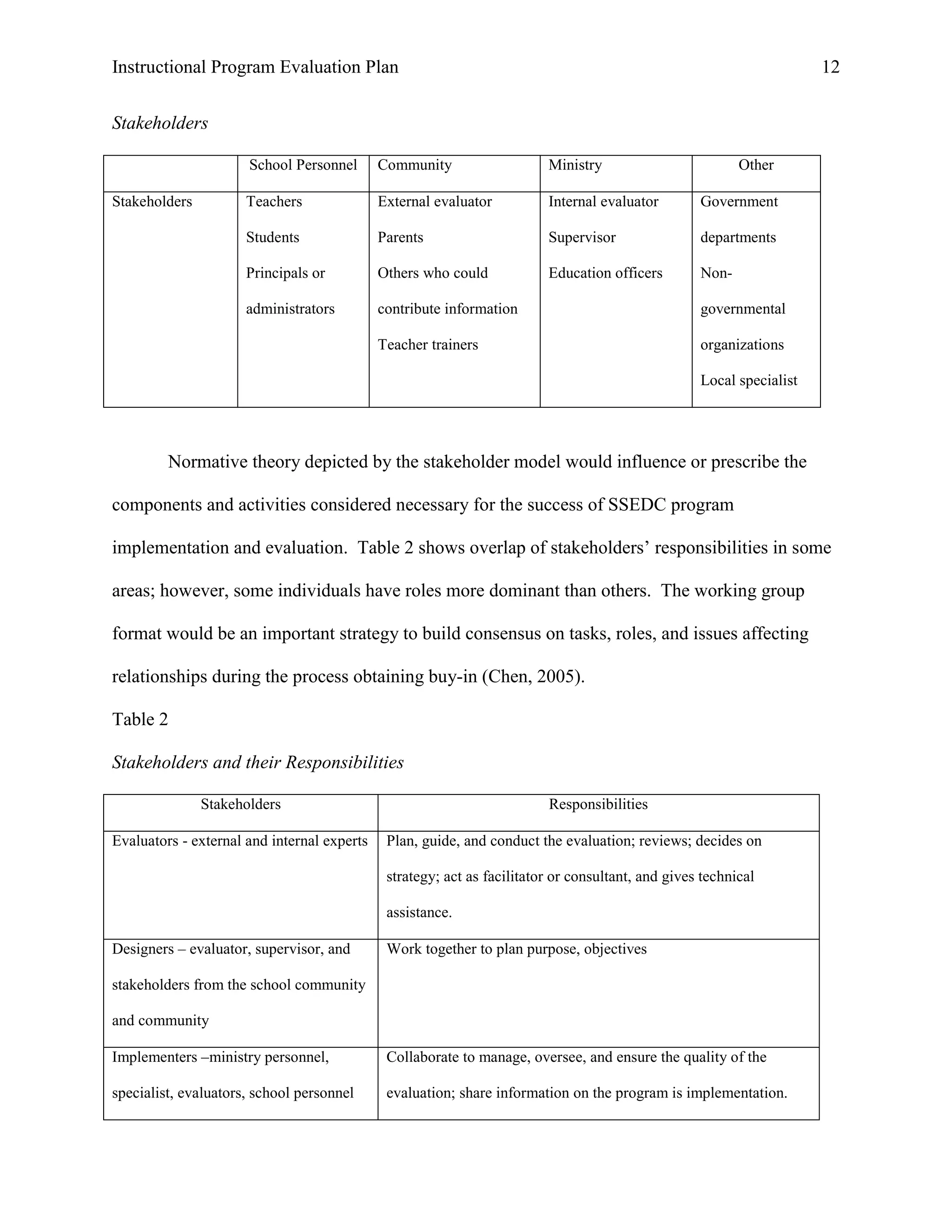
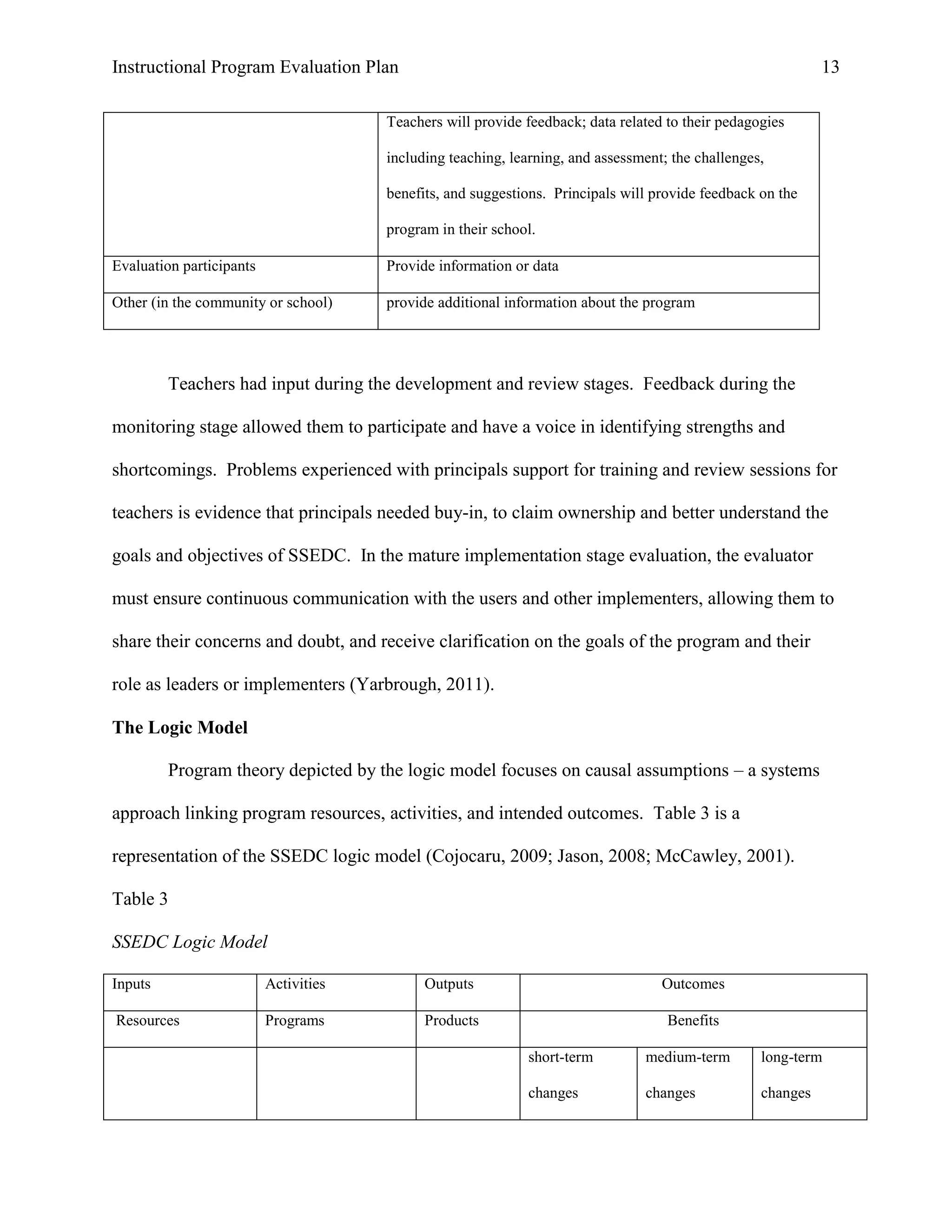

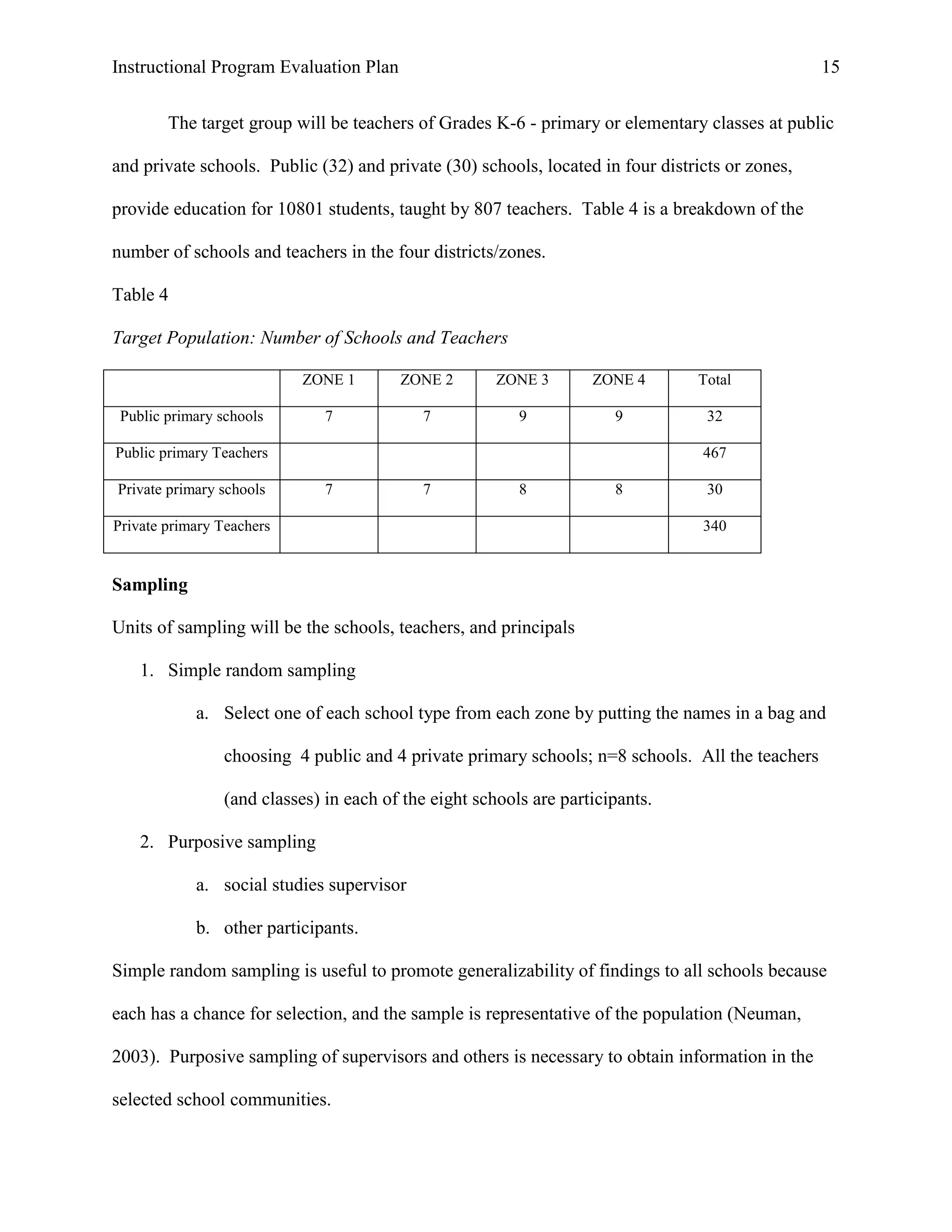
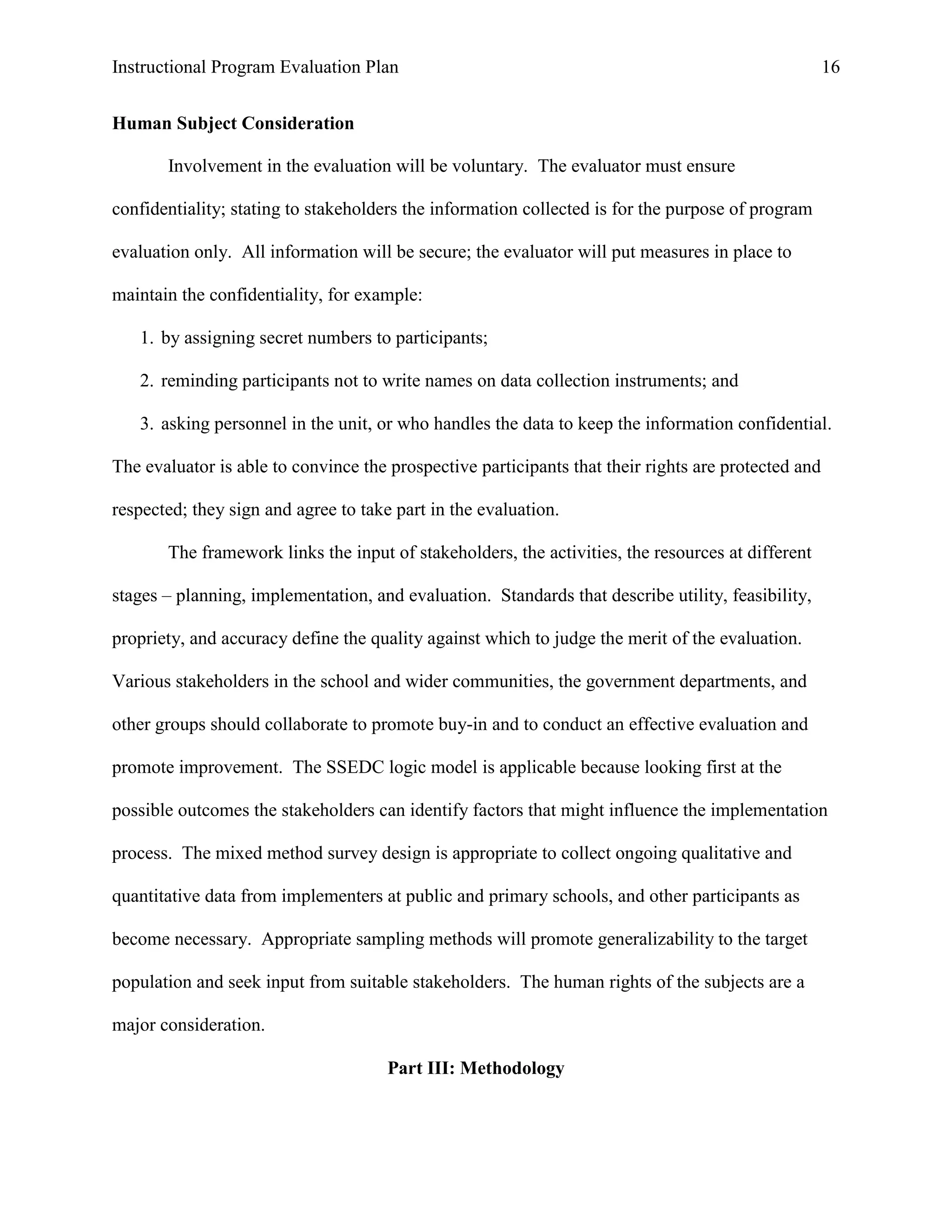
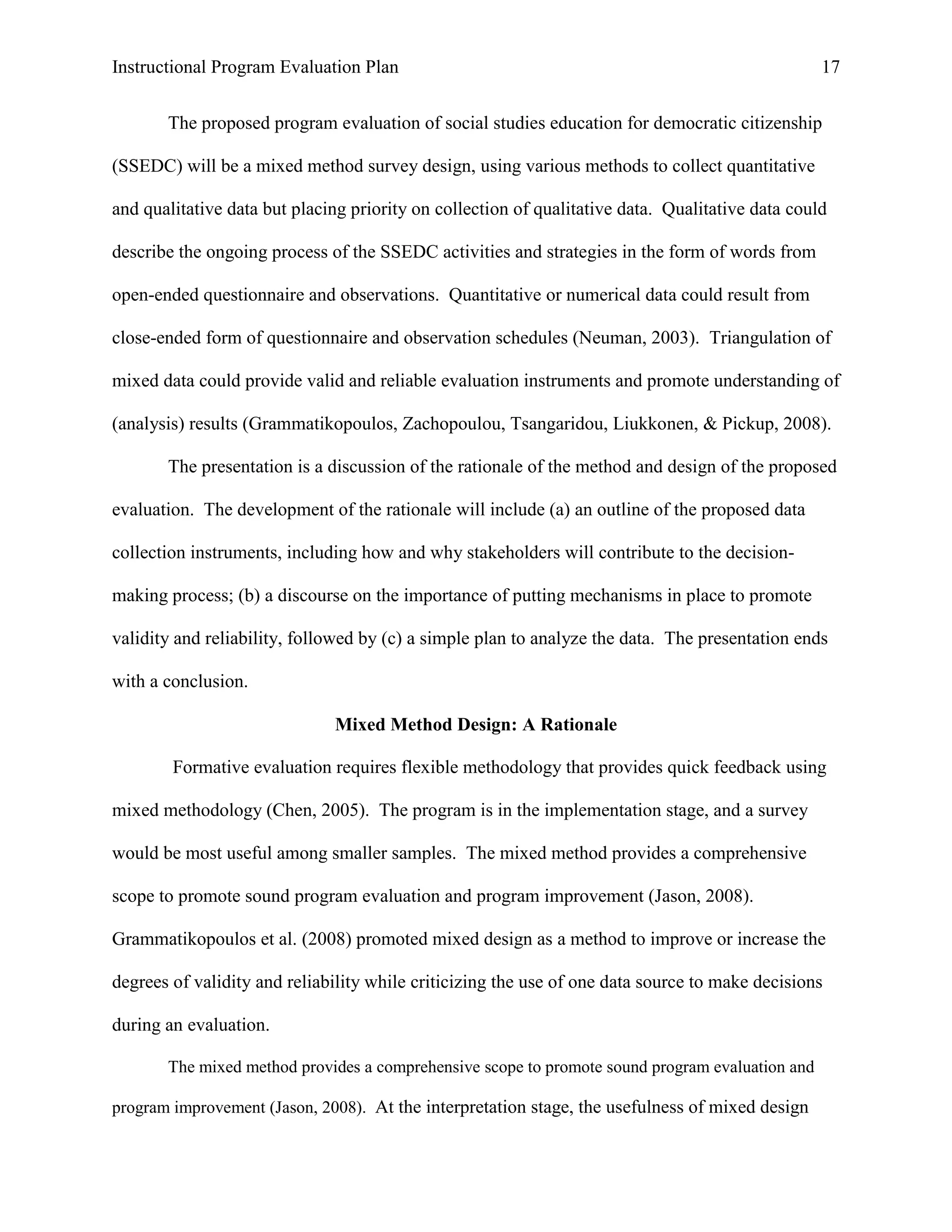

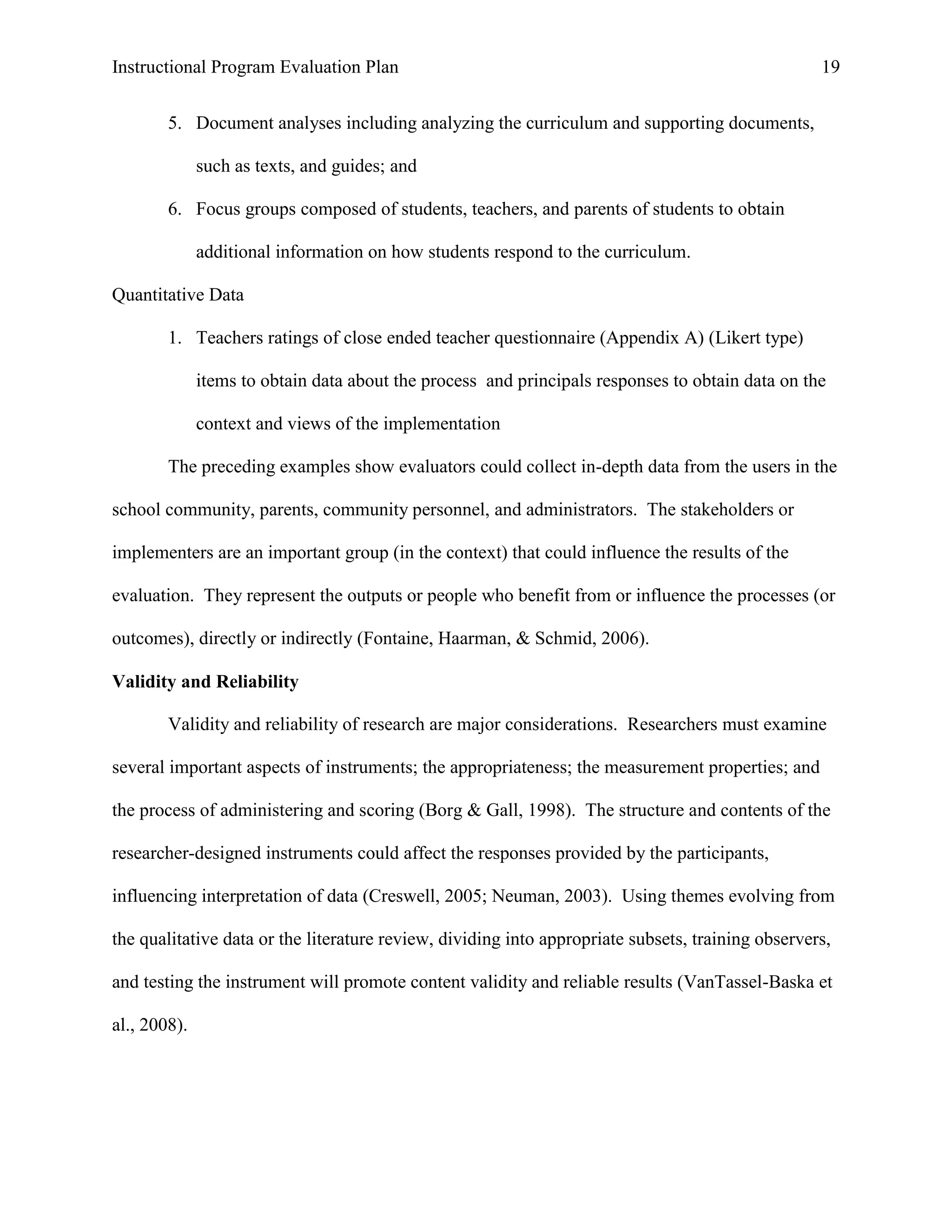
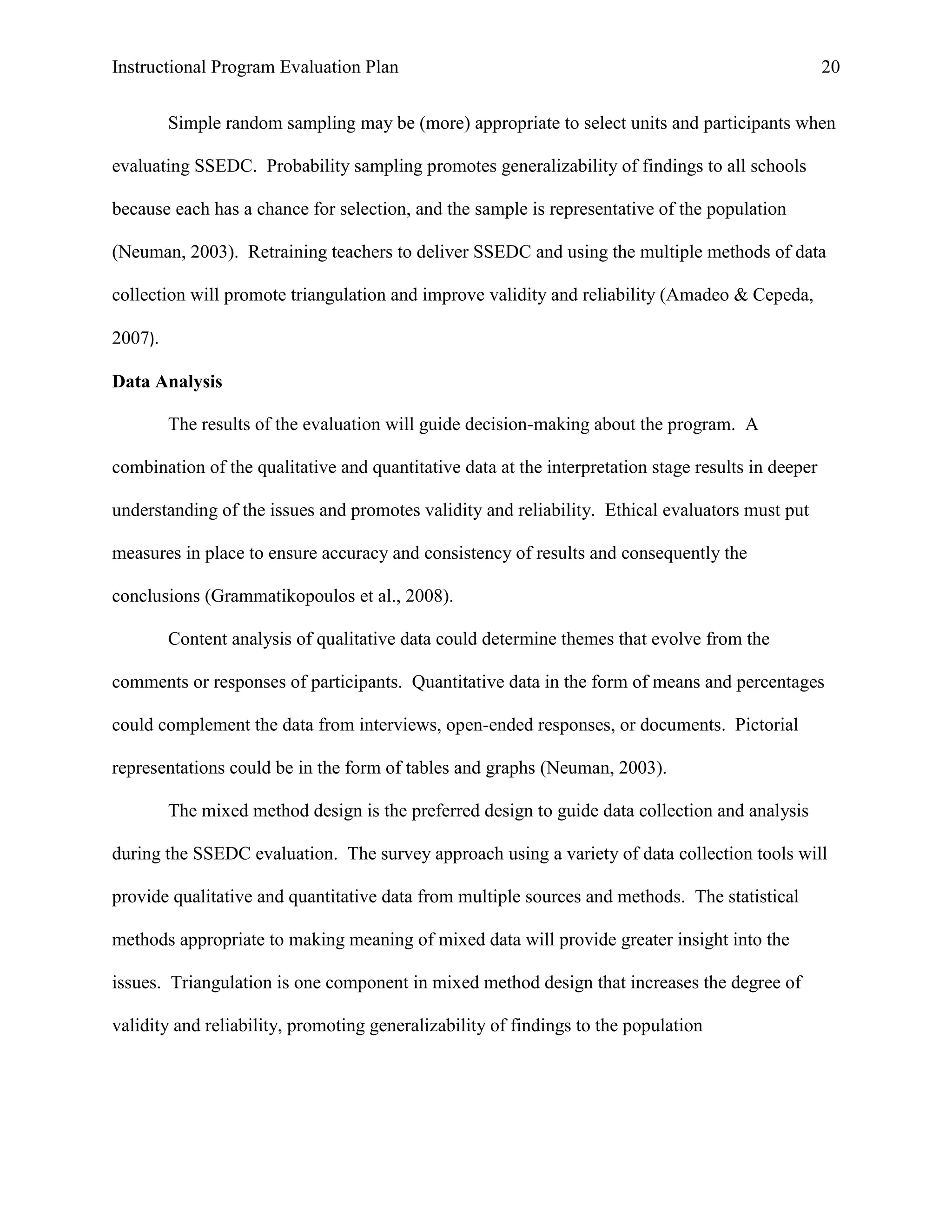

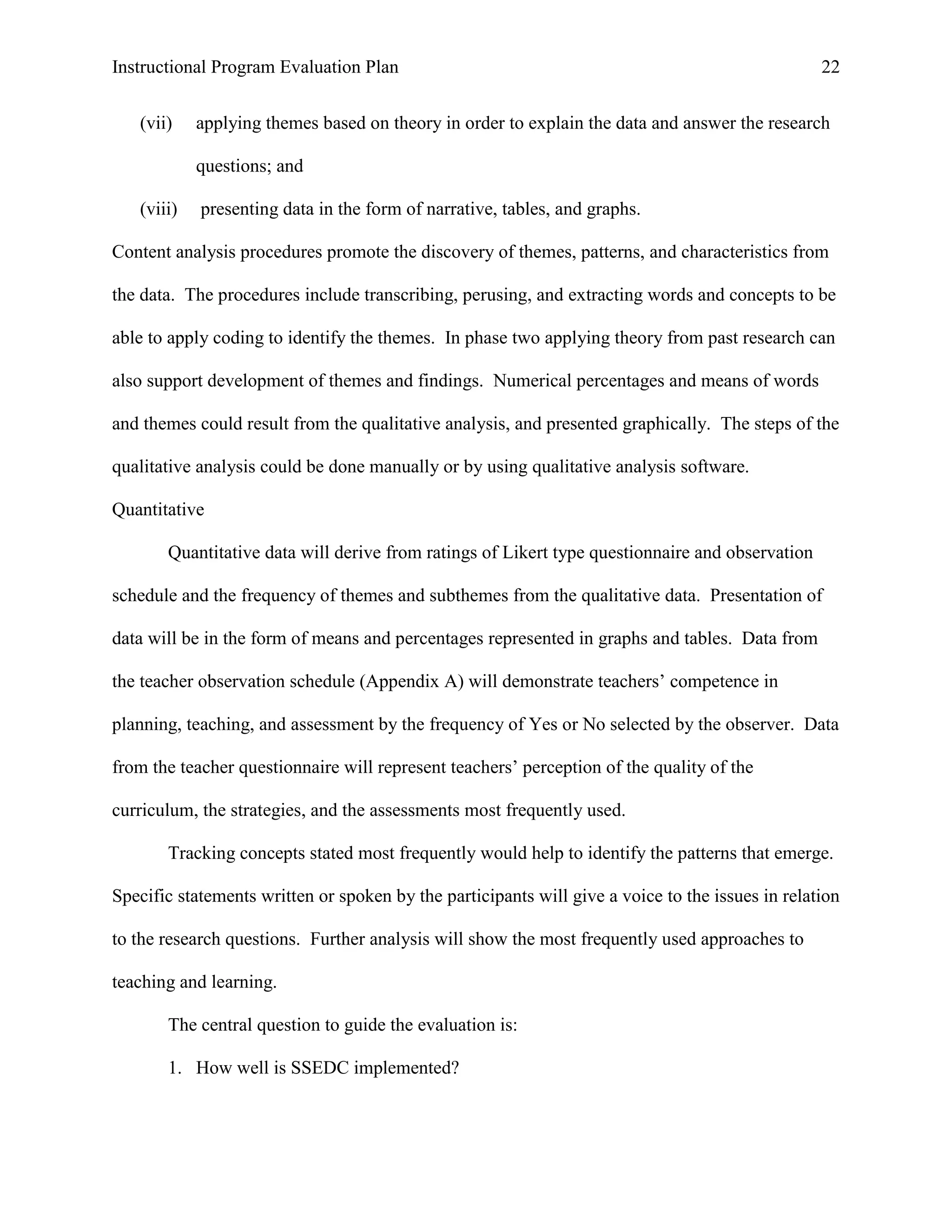

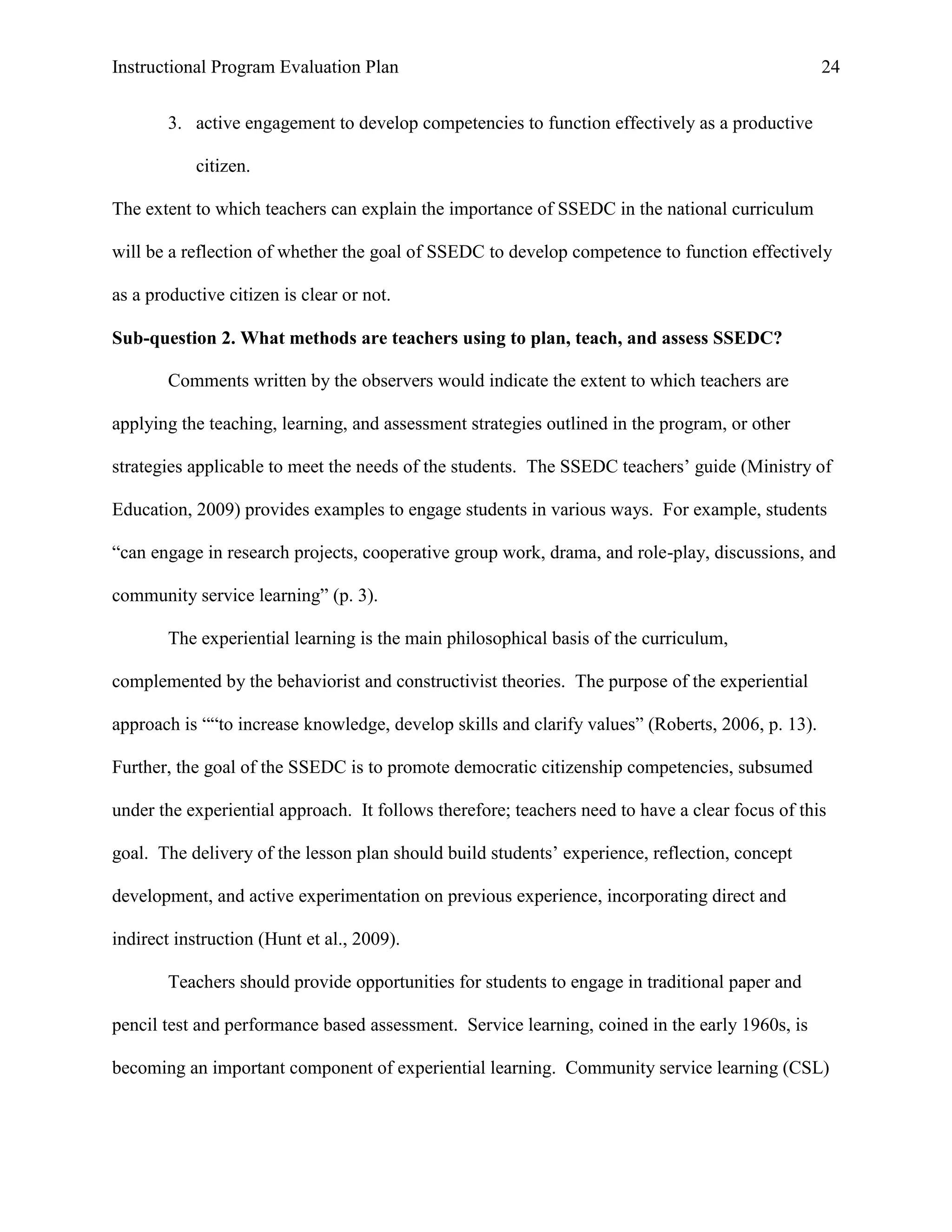
![Instructional Program Evaluation Plan 25
is a summative approach to link teaching learning and assessment. Schneller (2008) noted
service learning as an offshoot of Dewey‟s theory of experience, describing the strategy as
“pedagogy, curriculum, activities and programmes that embrace organized, hands-on community
service and volunteerism to enhance student learning and the schooling experience” (p. 294).
This aspect of experiential learning culminates a period of learning, giving opportunity for the
learners to demonstrate transfer of learning competencies in similar or new situations in the
school environment and in the community.
The documents will include the program document and teachers‟ lesson plans with their
reflections. The documents could bear evidence of the teaching, learning, and assessment
strategies that teachers use in planning and delivery of lessons. Numerous instructional
strategies are available for use in the classroom (See Teacher questionnaire, Appendix B).
Planning is important since “without a careful plan for presenting content, [students] experience
may be akin to a jigsaw puzzle” (Gunter, Estes, & Schwab, 2003, p. 39). Planning the
procedures portion of lesson plans requires teachers to select appropriate strategies to meet
identified needs, interests, motivations, and dispositions of learners. Teachers should consider
learner characteristics and learning styles when choosing an instructional strategy (Hunt,
Wiseman, & Touzel, 2009).
Sub-question 3. What problems are teachers experiencing?
The questionnaire should give further support to the delivery of the curriculum.
Although prescriptive, some variables might yet affect the implementation process, including the
allotted periods, the scope of the topics, the available resources, and the appropriateness of the
content for the prescribed grade level, and the learning environment. The evaluation could
highlight the difficulty and ease with which teachers were able to implement the objectives and](https://image.slidesharecdn.com/programevaluationplan-130809205232-phpapp02/75/Program-evaluation-plan-25-2048.jpg)
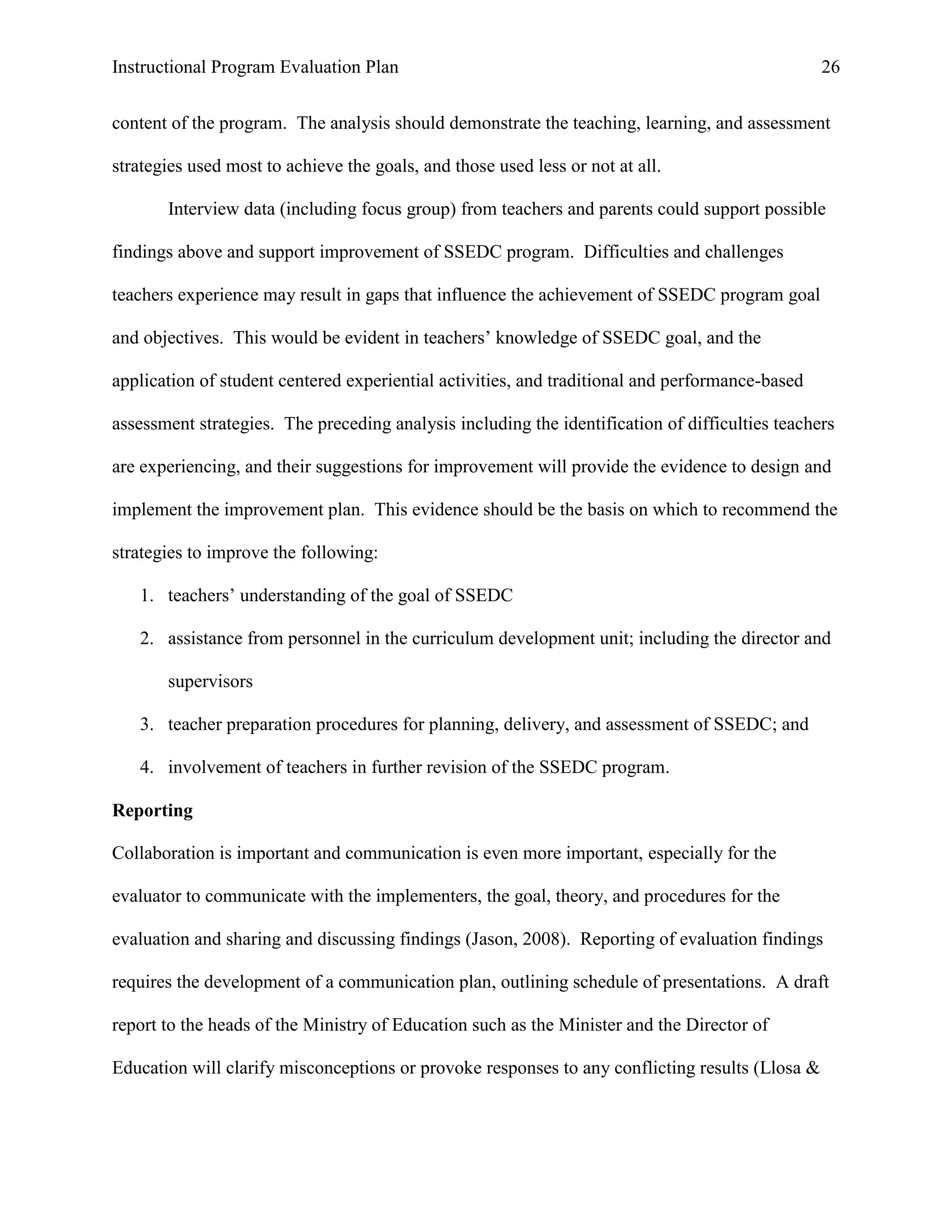
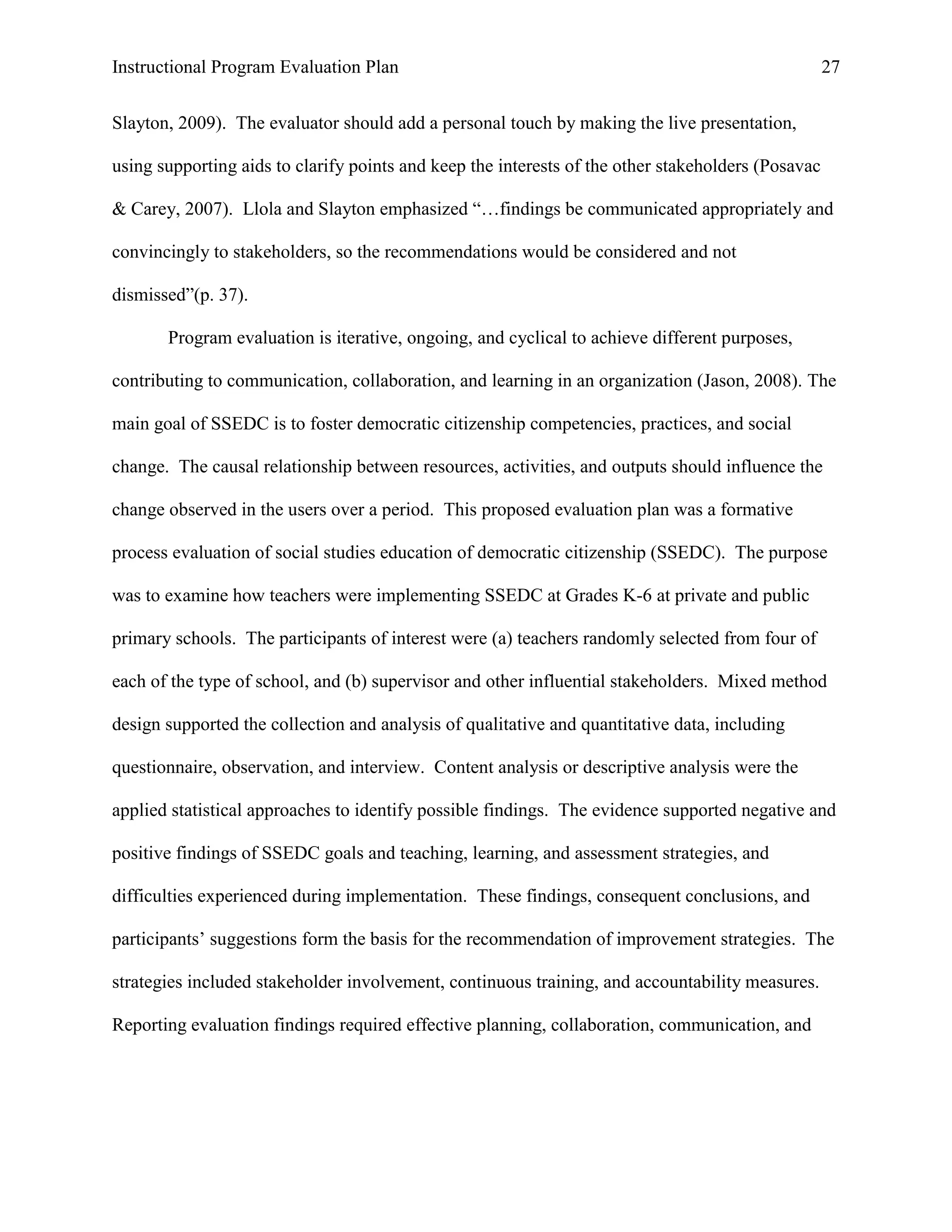
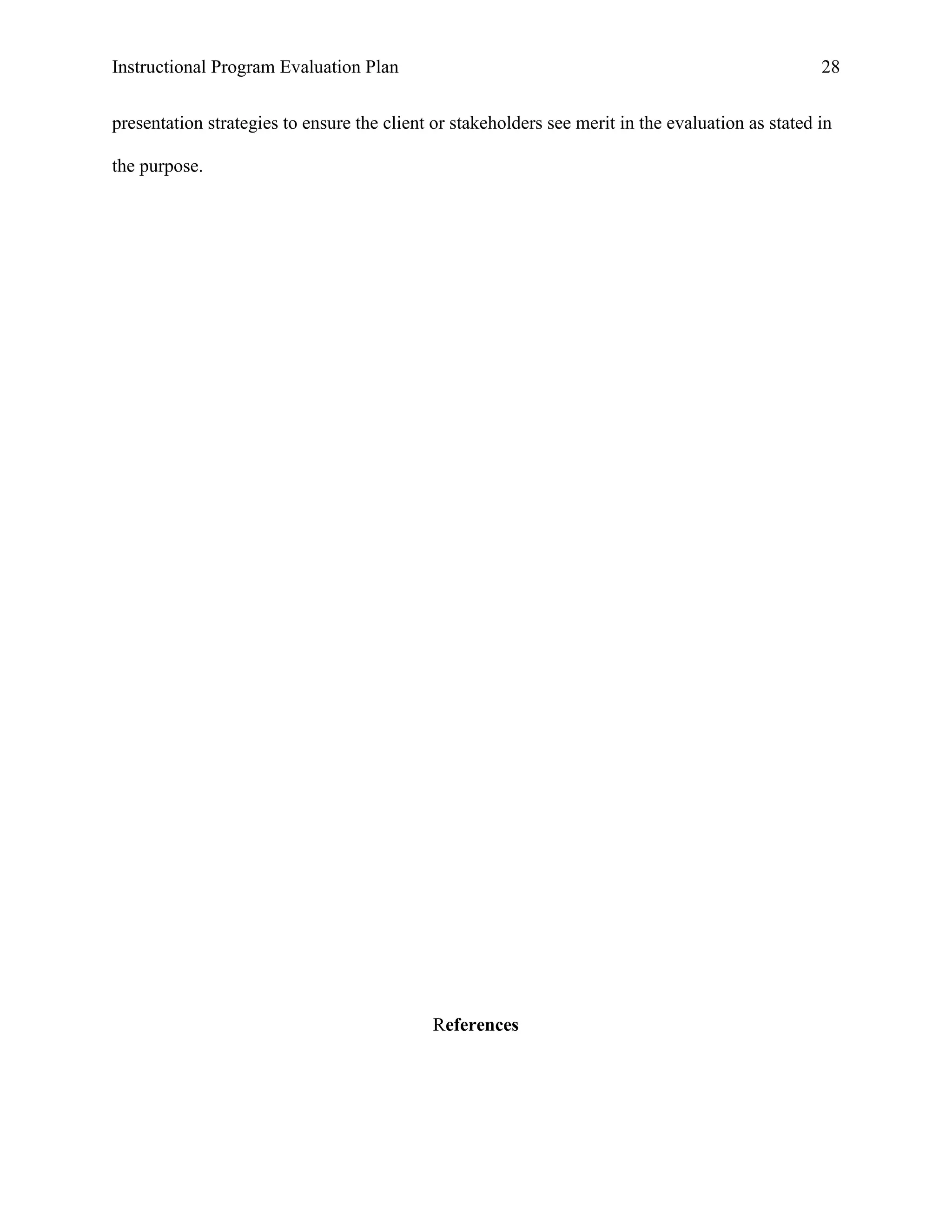
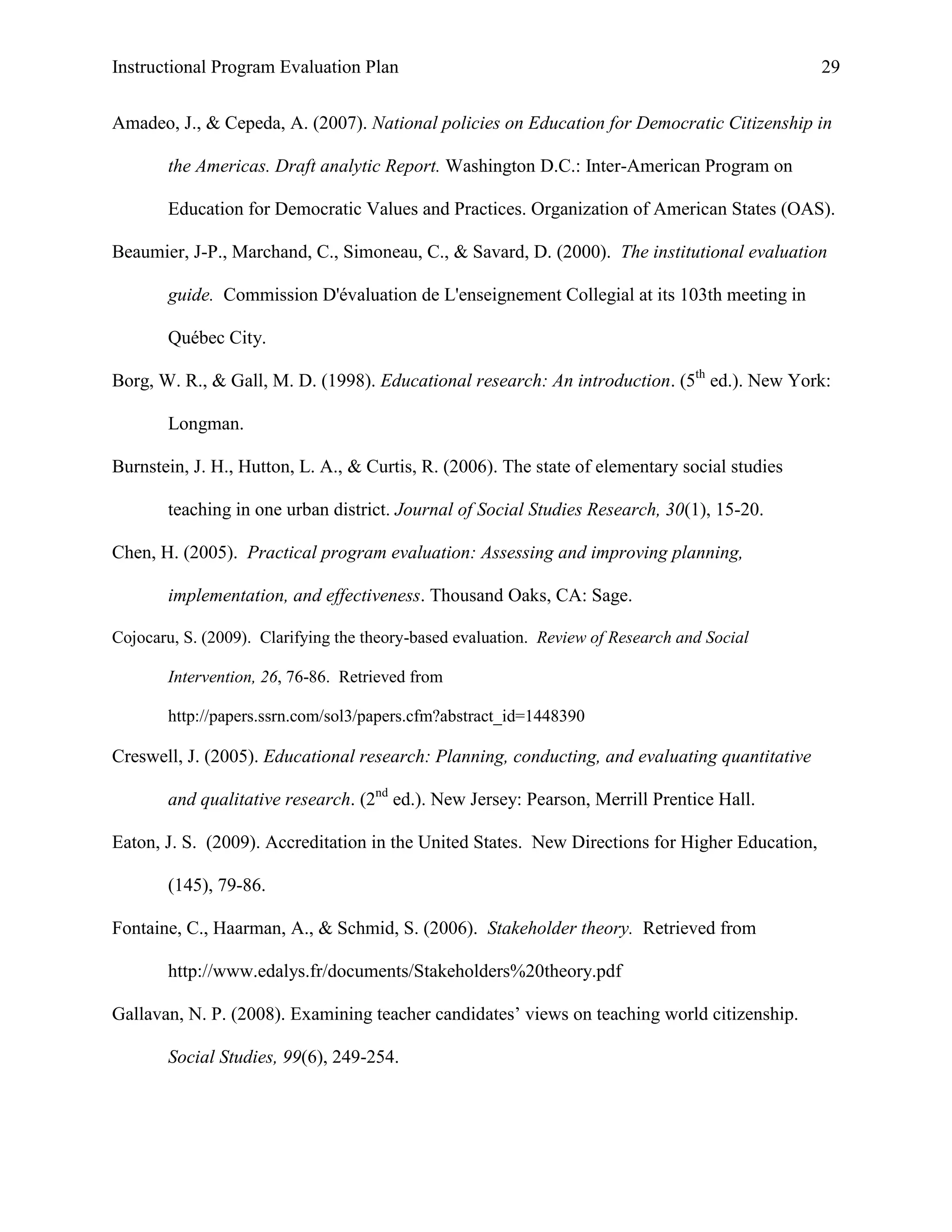
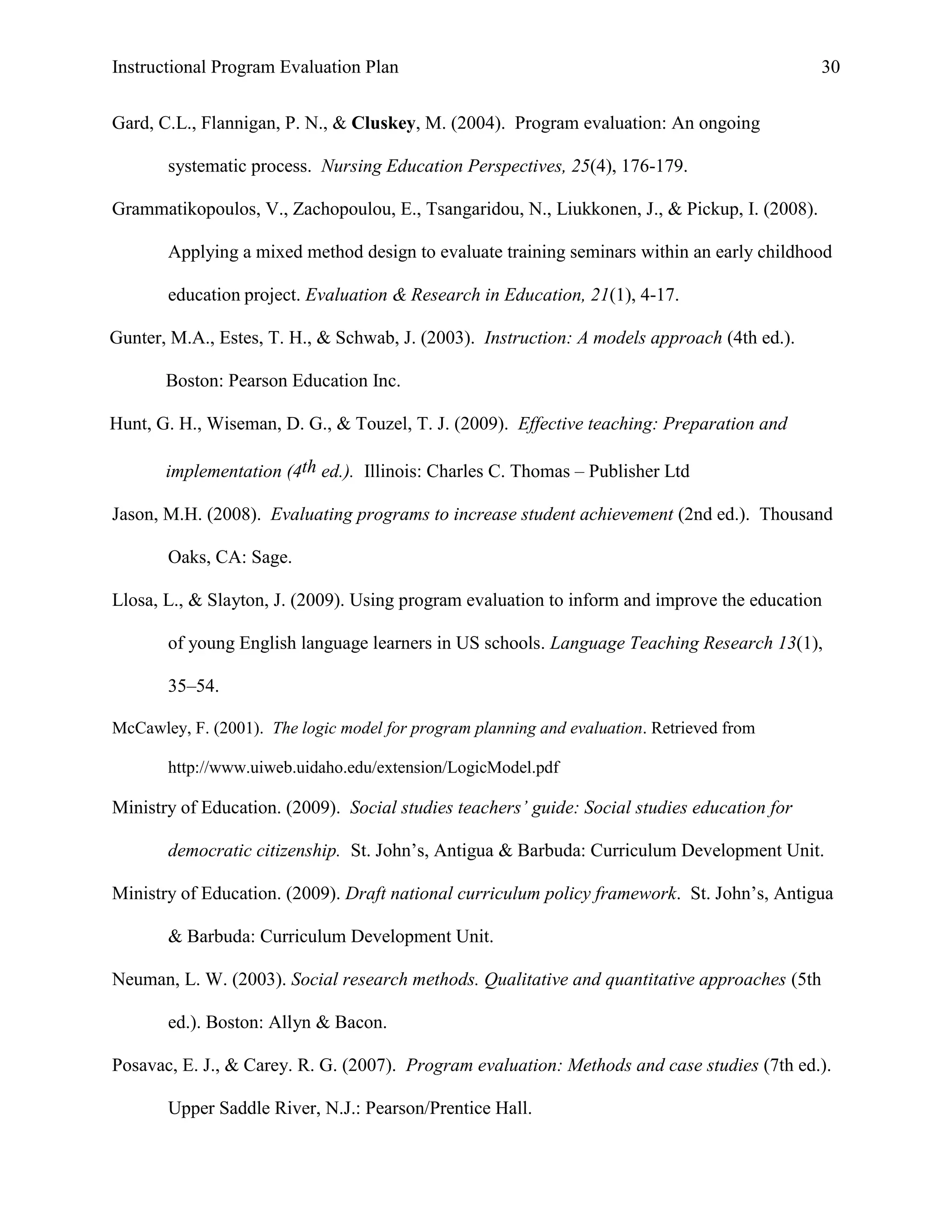
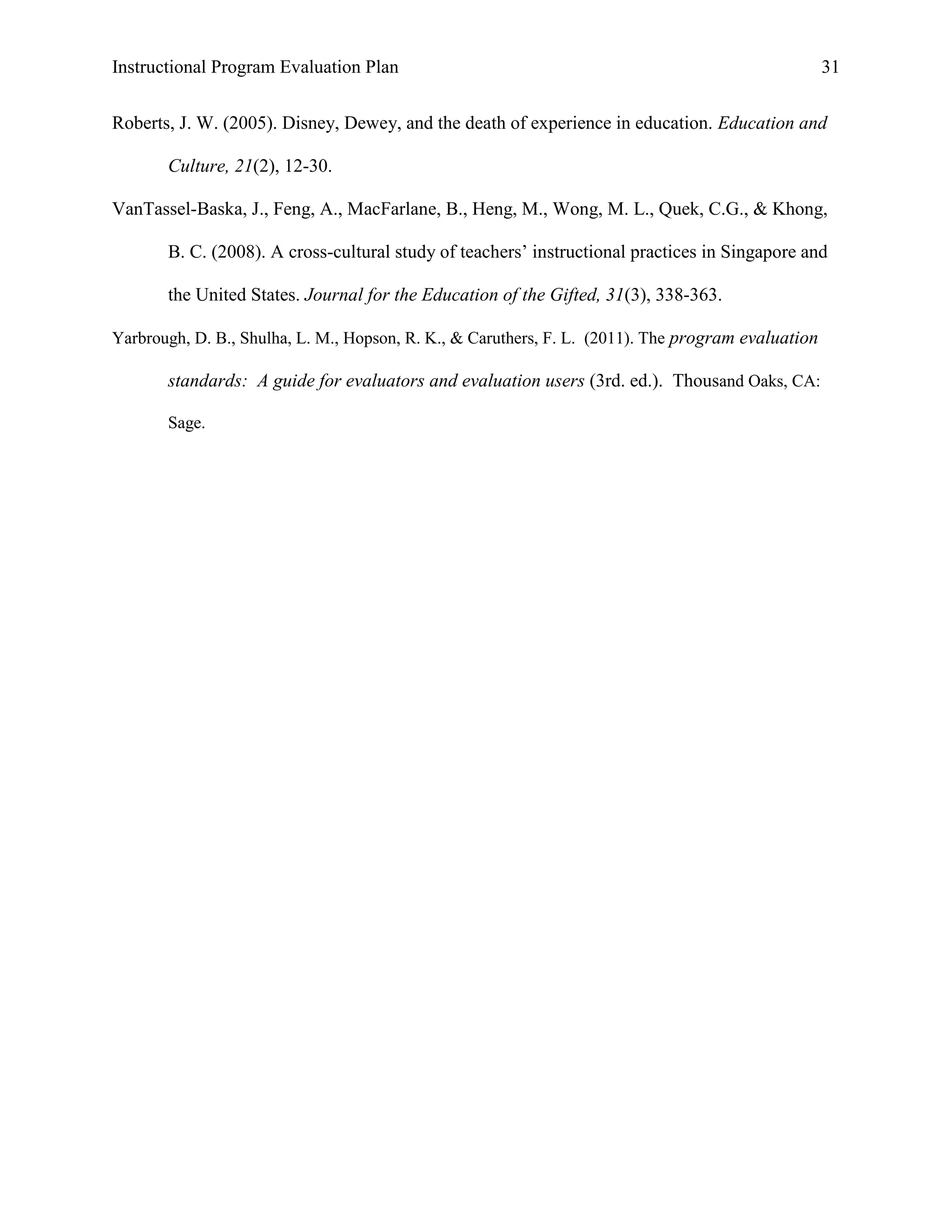

![Instructional Program Evaluation Plan 33
Appendix B
Teacher Questionnaire
Teacher: ________________________________________________________________
School: _________________________________________________________________
Class:
Term: __________________________________________________________________
Section A
i. How often do you use the social studies education for democratic citizenship (SSEDC) instructional guide
Always Sometimes Never
ii. Lessons contain realistic teaching time frames. Yes _____ No ______
iii. Number of teaching lessons/activities. Sufficient ____ Insufficient ____
iv. Number of available resources listed. Sufficient ____ Insufficient ____
v. Content for the level of teaching? Appropriate ____ Inappropriate_____
Section B
1.What objectives did you cover this term?
[use unit & objective numbers]
2.What content was difficult to teach?
3.What content was easy to teach?
Section C: Strategies/methods
1. Which teaching-learning strategies or activities do you use?
Research ____
Grouping ____
Peer teaching ____
Investigation ____
Simulations ____
Role Play ____
Dramatization ____
Community Service Learning ____
Lecture ____
Reading textbook ____
Project ____
Poster ____
Chart ____
Poem/song ____
Displays ____
Exhibitions ____
Questioning ____
Field trip ____
Journal ____
Discussion ____
Lecture ____
Vocabulary development ____
Presentation ____
Notes ____
Class work ____](https://image.slidesharecdn.com/programevaluationplan-130809205232-phpapp02/75/Program-evaluation-plan-33-2048.jpg)
![Running head: INSTRUCTIONAL PROGRAM EVALUATION 34
2. Which assessment methods do you use?
Journals ____
Investigation & Projects ____
Observation ____
Oral assessment ____
Pencil& Paper Tests/exercises ____
Worksheets ____
Practical / Performance Assessment ____
Portfolio Assessment ____
Peer assessment ____
Questionnaires ____
Community Service Learning ____
Section D
Respond to the following:
1. Describe TWO main difficulties you encounter in using the curriculum/program guide
2. State THREE suggestions for improving the curriculum
3. Explain the importance of SSEDC in the national curriculum.
4. Other comments. [e.g. your feelings, your practice, and students‟ responses]](https://image.slidesharecdn.com/programevaluationplan-130809205232-phpapp02/75/Program-evaluation-plan-34-2048.jpg)
